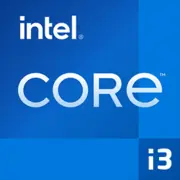Intel Core i3-13100T

Intel Core i3-13100T: A Budget Processor for Office Use and Beyond
March 2025
Key Features: Raptor Lake Architecture and Efficiency
The Intel Core i3-13100T, released at the end of 2023, remains a relevant option for budget PCs in 2025. It is the entry-level model in the 13th generation lineup, but its features make it appealing for specific tasks.
Architecture and Process Technology
- Codename: Raptor Lake-S (low TDP adapted version).
- Process Technology: Intel 7 (10nm Enhanced SuperFin).
- Cores and Threads: 4 cores (P-cores) / 8 threads. Hyper-Threading is enabled.
- Frequencies: Base frequency — 1.9 GHz, max turbo frequency — 4.2 GHz.
- Cache: L3 — 12 MB, L2 — 5 MB.
- TDP: 35 W (energy-efficient version with “T” index).
Performance
- Geekbench 6: 2030 (single-core), 6059 (multi-core).
For comparison: Ryzen 3 7300G scores around ~2100/6300 but is priced $20-30 higher.
- Integrated Graphics: Intel UHD Graphics 770 (max frequency — 1.5 GHz). Supports 4K@60Hz via HDMI 2.1 and DisplayPort 1.4a.
Key Features
- PCIe 5.0 support (up to 16 lanes).
- Hardware AI acceleration (GNA 3.0).
- Intel Thread Director technologies for optimizing multi-threading in Windows 11.
Compatible Motherboards: LGA 1700 Socket and Chipset Choices
The i3-13100T uses the LGA 1700 socket, like all 12th to 14th generation Intel processors.
Recommended Chipsets
- H610: Budget option ($70–90). Examples: ASUS Prime H610M-E, Gigabyte H610M S2H.
Limitations: No overclocking, 1 PCIe 4.0 slot, DDR4 support up to 3200 MHz.
- B660/B760 ($100–130): MSI Pro B760M-A, ASRock B660 Steel Legend.
Pros: 2 PCIe 4.0 slots, optional DDR5 support, more USB ports.
- H770/Z790 ($150+): For enthusiasts but excessive for the i3-13100T.
Choosing Tips
- Check support for DDR4/DDR5. For instance, DDR5 boards cost $20–40 more.
- Ensure HDMI 2.1 support if planning to use integrated graphics for 4K.
Memory: DDR4 vs DDR5 — Which to Choose?
The processor supports both types of memory, but with nuances:
- DDR4-3200: Cheaper (16 GB — $35–45), suitable for office tasks.
- DDR5-4800: More expensive (16 GB — $55–65), but offers gains in gaming and applications with high RAM utilization (e.g., video editing).
Recommendations
- For H610/B660 with DDR4: Kingston Fury Beast 16 GB DDR4-3200 ($38).
- For B760 with DDR5: Crucial CT16G48C40U5 16 GB DDR5-4800 ($58).
Power Supply: Minimum 400W with Headroom
The processor itself consumes up to 35 W, but when building a PC with a discrete graphics card, some headroom is needed:
- Integrated Graphics: PSU 300–400 W (e.g., be quiet! Pure Power 11 400W, $55).
- With an RTX 3050 level graphics card: PSU 500–600 W (Corsair CX550M, $65).
Tip: Don't skimp on the PSU. Even for a budget build, choose models with an 80+ Bronze certification and overload protection.
Pros and Cons of i3-13100T
Pros
- Low power consumption: Ideal for mini-PCs and home servers.
- Good single-core performance: Quick response in everyday tasks.
- Support for DDR5 and PCIe 5.0: Future-ready.
Cons
- Only 4 cores: In 2025, this is insufficient for heavy multi-threaded workloads (rendering, streaming).
- UHD 770 graphics: Only suitable for light gaming (CS:GO — 60 FPS on medium, GTA V — 40 FPS on low).
Use Cases: Where It Shines
1. Office and Study: Working with documents, browsing (20+ tabs), Zoom.
2. Multimedia: Watching 4K, streaming services, light editing in DaVinci Resolve.
3. Home Server/NAS: Low TDP allows for a quiet and economical system.
4. Casual Gaming: Minecraft, Dota 2, indie projects — using integrated graphics.
Practical Example: A user built a PC with an i3-13100T, 16 GB DDR5, and a 1 TB SSD for graphic work in Figma. Result: the system stays cool, silent, and handles the load well.
Comparison with Competitors
- AMD Ryzen 3 7300G ($140):
Pros: Better Radeon 740M graphics, higher multi-threading.
Cons: More expensive, requires DDR5.
- Intel Core i5-12400T (used, ~$100):
Pros: 6 cores.
Cons: Alder Lake architecture (older generation).
- Apple M2 (base version):
Pros: Energy efficiency.
Cons: Limited compatibility with Windows.
Practical Assembly Tips
1. Cooler: The boxed cooler is sufficient, but for quiet operation, consider the DeepCool AK400 ($25).
2. Case: Mini-ITX (Fractal Design Node 304) or compact MicroATX.
3. SSD: Make sure it's NVMe (e.g., Kingston NV2 1 TB — $60).
4. Upgrade: If planning to add a discrete graphics card later, choose a motherboard with PCIe 5.0 x16.
Final Conclusion: Who Is the i3-13100T For?
This processor is an excellent choice for:
- Budget office PCs: Low price ($120–130 in 2025), energy efficiency.
- Home media centers: 4K, HDMI 2.1, quiet operation.
- Starter builds: The potential to add a graphics card later.
Why this one? The balance of price, performance, and energy savings remains one of the best in its category. If you don't need 6 cores or top-tier graphics — the i3-13100T will be a reliable option.
Basic
CPU Specifications
Memory Specifications
GPU Specifications
Miscellaneous
Benchmarks
Compared to Other CPU
Share in social media
Or Link To Us
<a href="https://cputronic.com/cpu/intel-core-i3-13100t" target="_blank">Intel Core i3-13100T</a>